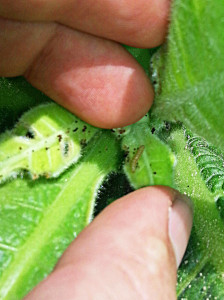Budworms Are Hatching, but It Pays to Wait Until They Reach Threshold to Treat
go.ncsu.edu/readext?358912
en Español / em Português
El inglés es el idioma de control de esta página. En la medida en que haya algún conflicto entre la traducción al inglés y la traducción, el inglés prevalece.
Al hacer clic en el enlace de traducción se activa un servicio de traducción gratuito para convertir la página al español. Al igual que con cualquier traducción por Internet, la conversión no es sensible al contexto y puede que no traduzca el texto en su significado original. NC State Extension no garantiza la exactitud del texto traducido. Por favor, tenga en cuenta que algunas aplicaciones y/o servicios pueden no funcionar como se espera cuando se traducen.
Português
Inglês é o idioma de controle desta página. Na medida que haja algum conflito entre o texto original em Inglês e a tradução, o Inglês prevalece.
Ao clicar no link de tradução, um serviço gratuito de tradução será ativado para converter a página para o Português. Como em qualquer tradução pela internet, a conversão não é sensivel ao contexto e pode não ocorrer a tradução para o significado orginal. O serviço de Extensão da Carolina do Norte (NC State Extension) não garante a exatidão do texto traduzido. Por favor, observe que algumas funções ou serviços podem não funcionar como esperado após a tradução.
English
English is the controlling language of this page. To the extent there is any conflict between the English text and the translation, English controls.
Clicking on the translation link activates a free translation service to convert the page to Spanish. As with any Internet translation, the conversion is not context-sensitive and may not translate the text to its original meaning. NC State Extension does not guarantee the accuracy of the translated text. Please note that some applications and/or services may not function as expected when translated.
Collapse ▲
Small tobacco budworm larva inside bud. Note black “frass”, or insect droppings, near the larva and the small feeding holds. As the leaf grows, these holes may expand, although new damage is not occurring. Photo: Demetri Tsiolkas
We observed our first budworm of the season this week in our research at the Upper Coastal Plain Research Station near Rocky Mount, and I’ve also gotten word from agents that growers are noticing larvae in their fields. At this point, budworm populations are very low, and I caution growers not to jump the gun with respect to making foliar insecticide applications.
We do not see a benefit from making foliar treatments for tobacco budworm before they reach threshold. In fact, treating too early for tobacco budworm can actually result in more, rather than less, insecticide applications. Our foliar insecticides in tobacco can only be expected to have residual activity on the treated leaf. They do not move to new leaves following an application. This means that as plants continue to grow, new leaves (the ones most attractive to egg-laying moths) will not be protected by too early insecticide applications.
It is not uncommon for prolonged budworm flights to occur where moths lay eggs over several weeks. It is better to time applications to threshold-level budworm populations than to hedge bets with an early application because you are more likely to hit a larger number insects with your treatment.
Physically observing plants via regular scouting is necessary to determine if tobacco budworm populations have reached the 10% treatment threshold. Just because moths are flying does not necessarily means that larvae are present in tobacco fields because budworms may feed on many different plants and predators may attack and kill large numbers of larvae feeding on tobacco.
More information


